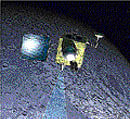
Within a month of discovering traces of water on the moon, another instrument on-board Chandrayaan-1 has confirmed how the earth’s lonely satellite generates water, which mankind hopes to harvest in future. The moon acts as a big sponge that absorbs electrically charged particles spewed out by the sun.
These particles interact with the oxygen present in some dust grains on the lunar surface, producing water. The water, however, is present in molecular form. It is not seen as liquid water, ice or moisture.
This latest discovery was made after analysing data collected by Sub-kilo electron volt Atom Reflecting Analyser (SARA), a Chandrayaan-1 instrument jointly developed by the European Space Agency and Indian Space Research Organisation.
The instrument is meant for studying the surface composition of the moon and the magnetic anomalies associated with the surface of the moon. The SARA discovery – to be published in the journal ‘Planetary and Space Science’ – also gives scientists an ingenious new way to take images of the moon and any other airless body in the Solar System.
Last month a NASA instrument called moon mineralogy mapper (M3) on-board the Indian payload found water on the moon. The findings created a stir in the scientific community as the moon was considered bone dry.
Dust grains
The lunar surface is a loose collection of irregular dust grains, known as regolith.
As the moon is bombarded by cosmic particles, the incoming particles are trapped in the spaces between the grains and absorbed. When this happens to solar protons – positively charged particles thrown out by the sun – they interact with the oxygen in the lunar regolith to produce water.
The signature for these water molecules was found by the M3 instrument. The SARA results confirm how the entire water process takes place. The SARA discovery opens up a new area for research.
Solar protons are absorbed by the lunar regolith. But not all of them are absorbed. One out of every five rebounds into space. In the process, the proton joins with negatively charged electron to become a hydrogen atom. The hydrogen shoots off with speeds of around 200 km per second and escapes without being deflected by the moon’s weak gravity.
“We didn’t expect to see this at all,” says Stas Barabash, Swedish Institute of Space Physics, who is the European principal investigator for the SARA instrument. An Indian team from Vikram Sarabhai Space Centre at Thiruvananthapuram was a partner in the research.
Although Barabash and Bhardwaj do not know what is causing the reflections, the discovery paves the way for a new type of lunar image to be made, which can unravel the magnetic properties of the moon. The knowledge will help ESA prepare better for its BepiColombo mission to Mercury, in which two instruments similar to SARA will be sent to study the inner-most planet.
